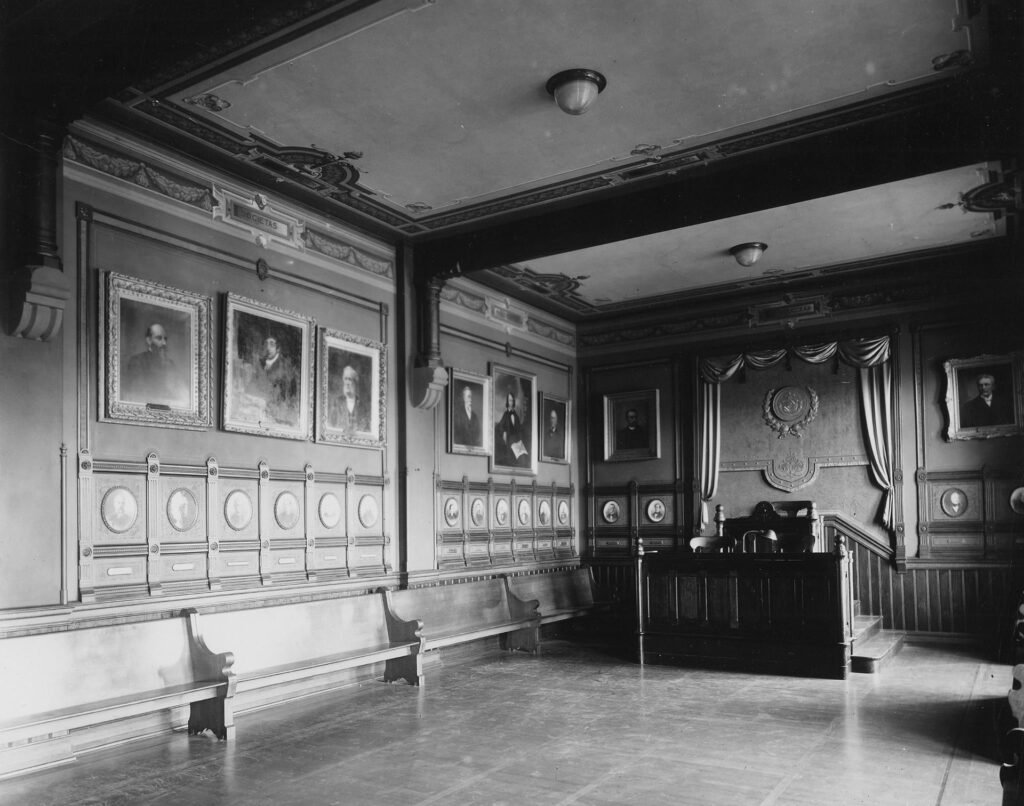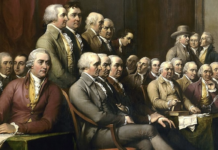![]()

The Historic Philodemic Hall Circa 1910
While studying law in Cork, I became quite familiar with the chief courthouse of Ireland’s second-largest city. Taking in its Classical façade, the eyes would be drawn up to the pediment and its inscription in stern sans-serif capitals: WILLIAM IV KING. In the main courtroom, the gilded Royal Arms still hovers above the bench as they did when those who fought for Irish freedom were sentenced to exile or to be hanged, in that very room.
Ireland protects them by law. The destruction, or even the possibility of damaging the irrecoverable fabric of an historic building is considered a greater evil than what offence the presence of these insignia may cause; it is illegal merely to cover them with a cloth. This follows international best practice regarding changes to the historical fabric of a building.
It is with deep sadness that I have seen recent pictures of the Philodemic Hall, stripped of its portraits, both the oils and the photographs of prominent Society members. These must be restored. We fear other irreversible changes to the artistry, woodcraft and historic content preserved by the hand of Jesuit Brother Francis Schroen. Healy Hall is a protected landmark, and the Register draws attention to the “Victorian interiors.” Previous appropriation of the space by the President’s Office removed the Philodemic library and lost the President’s desk on which every Society president had carved his name. Though most undergraduate societies at Georgetown no longer control spaces, the Philodemic Hall was endowed and is a gem, so that until now it has remained intact.
Fr. James Ryder founded the Philodemic Society in 1830. Its history tracked the Republic’s. The Society served as the only space where for its first 30 years the great issues, such as Abolition, were regularly debated. Following the Civil War, debate provided a means of averting conflict. Three Grand Reunions of Philodemic alumni (1867, 1871, 1874) brought those who had fought each other to hear orations and debate competitions, but also with hope to reconcile and to dedicate their efforts to expanding Georgetown as an institution that could act for the good of rebuilding the country. These meetings culminated in raising the funds needed to build Healy and pay off the debt, establish the Georgetown alumni association, and endow the Philodemic Hall and a Society office.
Fr. Patrick Healy, while planning what he called the New Building, reflects these ideas; he incorporated a purpose-built debate chamber as one of the central focal points. It was considered important to have a suitably grand room, not only to give debaters a feel for the spaces they may encounter in public life, but also to make a statement of the priority given to the art of oratory. The Philodemic occupied its chamber in December 1881. The final transformation was the artistry of Jesuit Br. Schroen, whose inspired freehand mural of vegetative motifs over moulded plaster graces the interiors of Healy’s north end. The photographs brought by the 1874 reunion attendees (with some further additions), the paired names of American orators, and the gilt Merrick Medal above the dais completed the temple of oratory.
Of course, despite the role of Maryland Catholics in procuring religious freedom, some participated in the greatest possible violation of freedom — slave ownership, and Jesuit institutions profited both directly and indirectly from slavery. This stain cannot be washed away. The Philodemic Hall’s photographs include a very small number of men who had sided with the Confederacy. Of course, they were not placed on the walls for anything other than they had been Philodemicians and Georgetown students. Their inclusion in Br. Schroen’s woodwork 40 years after the Civil War was certainly in Georgetown’s spirit of reconciliation, extending magnanimity towards the defeated in order to bring them into building a more peaceful and better future.
Before jumping into neo-iconoclasm, however, revising history and destroying art in a righteous pique, we should gaze over the cliff edge. If Georgetown’s history is so offensive that it must be effaced (and where would that end), then what point is there in remaining associated with such an institution? Hiding the history of a university or society that one has elected to join achieves nothing. Indeed, it effaces what was, in its time, a powerful act of reconciliation. We should add the photographs of the Philodemic’s first African American member, the first Jewish and woman Society presidents, and of Richard Alan Gordon who, from the Philodemic president’s chair, demanded that the Jesuit Fathers desegregate the College.
We can praise the desire to advance a truer presentation of history, including negative aspects, but as a scholar who has worked on historical preservation, I disagree with the extent of the present and planned physical alteration to the historic chamber. What the University has already done exceeds what students requested, and they have been dishonest with alumni. To alter the historic Philodemic Room’s décor and design is not only an act of philistinism, it fundamentally denies the possibility of remembrance and reconciliation through debating those with whom one fundamentally disagrees, the lesson that the Philodemic was designed to proclaim.
Dr. Joseph J. Flahive (CAS ’99; Ph.D., Edinburgh 2004; Ll.B., Cork, 2017) is a Philodemic Society alumnus and resides in Ireland
Do you share this sentiment? Sign on to a letter calling to end and reverse the reimagination of the Philodemic hall here.











